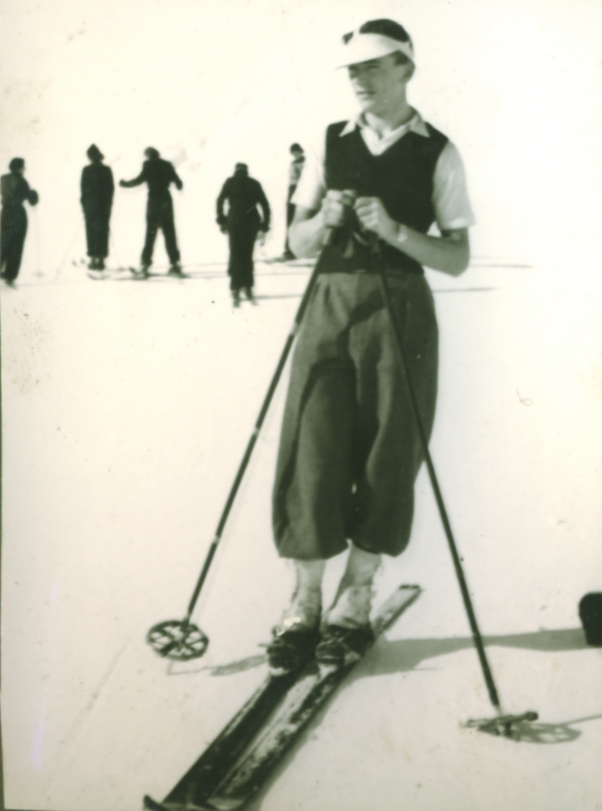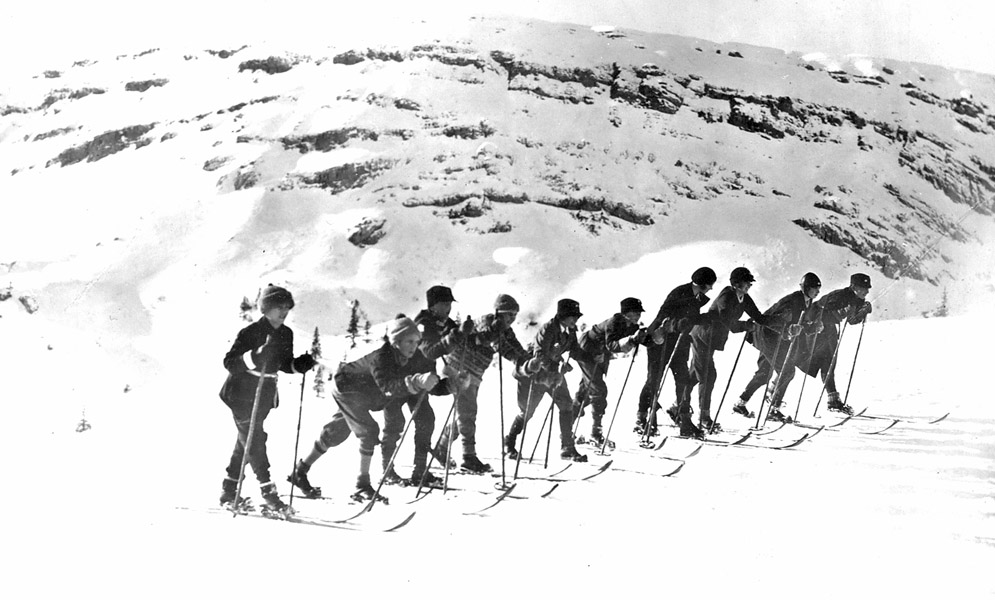Chapter 3: The Adventures of Skiing, 1928-1934
One development of enormous importance took place in late 1928. This transformed our lives in many ways. It was a great adventure in its own right.
My mother’s search for something suitable to work off the energy of her three sons in the winter holidays bore fruit. Someone said “What about skiing?” Instant fright at the cost of a St Moritz or Mürren would have put many people off but not this lady. She discovered that there was a tiny skiing resort in the Swiss Jura run by an appropriately-named Donald Greenland. In the weeks approaching the season he ran the skiing department in Harrods and there she went. Information was produced, clothes were bought and the expedition was set in hand. She had been at Finishing School in Geneva so had some knowledge of the area. Off we went, regardless of the fact that Nigel’s vision was close to zero and my one handed father could only wield one ski stick. They would have to do the best they could.
My mental travel pictures of our first trip include the surging horde crying ‘porteur’ as the cross-channel ship docked at Calais. Garbed in blue denim jackets and trousers with dark blue berets, their basic equipment consisted of a heavy leather strap which they threaded through the handles of several suitcases, heaving the load to their shoulders and leading the way to a train. Sleepers were a luxury far beyond us. Some compartments had corner seats Pour Les Mutilés, obviously designed for Papa and adding distinction to our presence. The night was a bore as we had not yet developed the technique of sleeping in luggage racks, but the arrival at Lausanne station was bliss. Whilst British railway restaurants had few charms the Swiss ones were a delight. Restored by breakfast and with ever-increasing excitement we skirted the Lake of Geneva to Nyon, boarding there a country train which climbed slowly as our excitement grew to St Cergue. It continued thereafter through a low mountain pass to La Cure in the French Jura.
The village of St Cergue can have changed little in the previous hundred years. Its winter awakening was due to British enterprise by the founder of the Dôle Ski Club, an imaginative warrior of the 1914 war. Swiss hotel keepers were quick to see the value of the winter trade which skiing would bring and Monsieur Auberson was no exception. The hotel in the village carried his name and he also owned the rather smarter Hôtel Observatoire on a ridge higher up towards the Lake of Geneva. It lives up to its descriptive ‘Panorama Grandiose’ on an early map. Ruskin saw it on his travels and commented favourably on the sight across the lake to evening sun on the Dents du Midi beyond, at a time when summer tours were becoming popular.
The number of members in the resort over the Christmas holidays would have peaked at around 250. Everyone joined the Ski Club, named after the local mountain, and new members were warmly received. Families got to know each other and kept up the contacts in England.
There was no ski shop as such. A general shop with all the things visitors of the day might buy, ‘woodwork bears and won’t work clocks’ as one writer of the time unfairly described them. A small workshop abutted it and here my first skis were bought, wooden objects without trimming on edge or sole. A bent metal fixing held the toe of the boot, with a leather strap and buckle holding the heel. The total cost of the skis was £3 for the pair. One could kneel on one’s skis without hindrance and ski boots were light and as good for walking as skiing.

All ski instruction was in British hands with classes for different grades and for children. The Ski Club of Great Britain, already twenty five years old, had tests, but it took a couple of years or more to reach the bottom rung. One had to show that one had mastered the various turns: Stem, Telemark, Christie and Jump as well as completing a qualifying timed run. At a lower level the Dôle Club and others had their own tests. At a time when every vertical foot skied had to be climbed first, gaining experience was a slow process.
There were no village restaurants, tea shops or bars available so all evening entertainment was run by the Club and took place mainly in the Hôtel Observatoire where all were welcome. It will astonish modern skiers to learn that everyone changed for dinner, Dinner Jackets for men and Eton Jackets for boys. With all travel by train there was no baggage weight limit to worry about.
Equally there were no restaurants in the mountains. Pack lunches were provided free by hotels and the whole day was often spent on the slopes. A substantial tea in the hotel on return with hot chocolate and cherry jam was very popular. There would then be great activity in the ski room in the cellars with the smell of hot wax and solid methylated Meta burning in the waxing iron as skis were prepared for next day’s activities.
One often took the ordinary train to La Givrine four kilometres away but the vertical gain was less than 600 feet. The run back was pleasant but more akin to langlauf than downhill skiing. M. Auberson would arrange a picnic in the snows at La Givrine each winter with tables and benches constructed in the snow and insulated to some extent for seating. The hotel staff served a fine repast. For the young there was skiing by day with some sledding or lugeing and floodlit skating as it got dark. No wonder we slept well.
The ascent of the 5000ft Dôle, 1500 feet above the railway stop, was attainable in later years. The proper means of preventing skis from sliding backwards down hill was by the use of skins, initially from seals. Tied to the sole of skis, these meant that one could slide one’s skis forwards but not backwards. As these were deemed expensive we used ropes which were made of cord, knotted in diamond pattern, which could be slid over the ski. The snag was that the ski had to be lifted and put down for each pace forward. I lived with this system until my resourceful mother discovered a washed up seal on the Pembroke coast and made a set of skins for me.
For three years this programme continued with increasing numbers through taking relations and friends, though my father and Nigel decided that the sport was not really for them. Then came the great depression with its worldwide effects which meant that there was no money for trips of this kind until some recovery was in sight.
Looking back I believe that there were two great advantages for me of the time and the sport. Numbers were so small that one got to know people really well over the three seasons. Secondly, skiing skill rather than age determined the groups that would ski together. As we grew older the friendships resulting across age barriers opened doors for me to many different interests and activities throughout my life. Two people of immense importance were Harold Taylor, a New Zealander of outstanding achievements who became a friend of close on seventy years and Brian Palmes, a retired Naval Captain. He was always referred to a ‘God’s Uncle’. He became an honorary godfather to us three boys. Both will appear later in my story.
In 1933 we returned to St Cergue to start skiing again. At just seventeen I was able to play an adult part and help the Club in various active ways. The local Challenge Shield was the star race each season. Ski racing was something very different from what the television viewer sees today. It is worth describing the equipment and racing of the day.
Advances had been made in equipment in the two years of the depression when few people had been able to ski. Bindings no longer allowed one to kneel on one’s ski without restraint. When the heel was lifted an inch or so some pull started to keep heel and ski together. Hard edges for skis had started to appear providing more bite on the snow when one turned - hard plastic the safest and steel rather daring. Taking the new edge round the curve of the ski, where it might have been useful, was discouraged. Ski sticks, cut from the hedgerow, still carried their species identifying bark and the loops provided were leather boot laces threaded through a hole in the wood. For some reason it was considered unsafe to put the loop over one’s wrist. For racing purposes a piece of string was tied to the loop and then with an eighteen inch gap, round the wrist. In the event of a fall the sticks could be recovered in quick time.
Turning to a particular race, the leisurely climb up the course to our lunching place took some time. A packed lunch was eaten. No restaurants or other buildings existed though the odd cow byre was occasionally useful for shelter. After lunch the race was organised before we climbed to the course start. There were ten or a dozen starters and we were issued with racing numbers. It was to be a schemozzle start, all starting off together as in cross-country running.
Next was the steep climb towards the top of the diminutive mountain. Long traverses took us there rather than attempting to scale the steep part which we could race down. This top of the course would be raced on unprepared, previously unseen, unpractised and uncontrolled track. As in athletics it was important to get ahead at once which always led to some confusion. The bold spirits would point for the steepest descent, whereas the more cautious, inconveniently placed might wish to lead off on a traverse. With twelve different choices of starting direction it took time for all to get moving, a problem not found in athletics.
One highly developed skill in this age was the ability to schuss a straight line through bumps and lumps and variations of snow condition. The first 600 foot drop was taken in this way by the better skiers. With much speed and great uncertainty about the snow condition, a decision had to be taken as how to make a sharp turn to head off in a new direction through the trees. It would be easy to be involved in a catastrophic fall which would consume time in recovery. I chose a tactical fall to take off speed, point me in the right direction and have me moving again quickly without being overtaken. The exhilaration of being ahead and reasonable knowledge of the remainder of the course presented no more problems. As the winner I arrived 45 seconds before the next competitor. Today in any major race, the first dozen are spread out over a span of a few seconds.
Years later I remember Peter Lunn, one of Britain’s principal racers in the 1930s, divulging that he had come ninth in a World championship race in spite of the fact that he had fallen three times. Perhaps he had refined the tactical fall to its finest point before more sophisticated methods evolved.
